This significantly revised 10th Edition focuses on applying theories and research in educational psychology to an educator’s work in the classroom. Using an integrated-case approach, authors Eggen and Kauchak begin each chapter with a case study taken from actual classroom practice, and then weave the case throughout the chapter, extracting specific illustrations and, in some instances, using dialogue directly from the case to emphasise the application of chapter content to the classroom setting. Many additional concrete examples taken from both classrooms and daily living further illustrate the content of each chapter in a comprehensive and approachable manner.
Read more
1. Educational Psychology: Understanding Learning and Teaching 2. Cognitive and Language Development 3. Personal, Social, and Moral Development 4. Learner Diversity 5. Learners with Exceptionalities 6. Behaviorism and Social Cognitive Theory 7. Cognitive Views of Learning 8. Complex Cognitive Processes 9. Knowledge Construction in Social Contexts 10. Motivation and Learning 11. A Classroom Model for Promoting Student Motivation 12. Classroom Management: Developing Self-Regulated Learners 13. Learning and Effective Teaching 14. Increasing Learning Through Assessment 15. Standardized Testing and Learning
Read more
This title is a Pearson Global Edition. The Editorial team at Pearson has worked closely with educators around the world to include content which is especially relevant to students outside the United States. Reflect on realistic classroom scenarios. Case Studies at the start of each chapter present classroom scenarios that place chapter content within the context of classroom learning and instruction. Each opening chapter case continues to build throughout each chapter. (See pages 264, 266, 267, 268, 274, 276, 285, 287, 300, 302, for examples.) Other case studies are embedded in the text to illustrate other key concepts. (See pages 305 and 309-310 for examples.)Apply chapter content directly to the classroom. Educational Psychology and Teaching provides the reader with specific and concrete suggestions for classroom practice (See pages 300-306 for an example.)Apply chapter content meaningfully to life in other ways. Ed Psych and You asks readers to reflect on how educational psychology can be applied to their own lives as they live them every day. (See pages 292 and 295 for examples.)Learn strategies to use in the classroom. Classroom Connections features offer suggestions and illustrations for applying content to specific learning and teaching situations at different grade levels. (See pages 281 and 294 for examples.)Apply in-depth understanding of psychological theories to classroom practice. Analyzing Theories provides detailed evaluations of key psychological theories, such as those by Erikson and Kohlberg, focusing on criticisms and contributions, including applications to education. (See page 298 for an example.)Understand developmental change. Developmentally Appropriate Practice helps teachers accommodate developmental differences in students and provides suggestions for how to adapt chapter content to different developmental levels. (See pages 307 for an example.)Consider how new technology affects the learning environment. Technology, Learning and Development focuses on key contemporary topics surrounding technology in the lives of students, such as cyberbullying, social connections, and computer-based testing. (See pages 283-284 for an examples.) Key content changes include: UPDATED: Learning – Learning is at the heart of educational psychology, and Chapters 6-9 were reordered and rewritten to reflect recent developments in the understanding of how students in classrooms, and people of all ages, learn. Also included is new content on the learning sciences. (See Chapter 9 for examples.)NEW: Knowledge construction – A new chapter addresses the ways in which learners construct their own knowledge, emphasizing that learning is substantively a social process. (See Chapter 9 for examples.)NEW: Standards and assessments – Standards, accountability, and value-added teacher assessment are now mainstays in the classroom. New content addresses the ways in which these practices affect teaching and learning, including the controversies involved with each. (See Chapters 14 and 15 for examples.)UPDATED: Recent developments in neuroscience – Neuroscience is providing researchers, educational leaders, teachers, and students with new insights into the teaching-learning process. Expanded coverage helps the reader to use this information to increase learning for all students regardless of their backgrounds. (See pages 40-45 and 361-362 for examples.)NEW: Personality and emotion – Personality and emotion play an important role in motivation and how effectively people learn and develop; both are significantly influenced by home and school e
Read more
Key content changes include: Learning – Learning is at the heart of educational psychology, and Chapters 6-9 were reordered and rewritten to reflect recent developments in the understanding of how students in classrooms, and people of all ages, learn. Also included is new content on the learning sciences. (See Chapter 9 for examples.)Knowledge construction – A new chapter addresses the ways in which learners construct their own knowledge, emphasizing that learning is substantively a social process. (See Chapter 9 for examples.)Standards and assessments – Standards, accountability, and value-added teacher assessment are now mainstays in the classroom. New content addresses the ways in which these practices affect teaching and learning, including the controversies involved with each. (See Chapters 14 and 15 for examples.)Recent developments in neuroscience – Neuroscience is providing researchers, educational leaders, teachers, and students with new insights into the teaching-learning process. Expanded coverage helps the reader to use this information to increase learning for all students regardless of their backgrounds. (See pages 40-45 and 361-362 for examples.)Personality and emotion – Personality and emotion play an important role in motivation and how effectively people learn and develop; both are significantly influenced by home and school environments. New coverage focuses the reader on how to create the kinds of environments that capitalize on these insights. (See pages 424-430 for examples.)
Read more
Product details
ISBN
9781292107561
Published
2015
Edition
10. edition
Publisher
Vendor
Pearson Education Limited
Weight
1460 gr
Height
275 mm
Width
215 mm
Thickness
36 mm
Age
P, 06
Language
Product language
Engelsk
Format
Product format
Heftet
Number of pages
752
